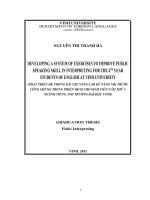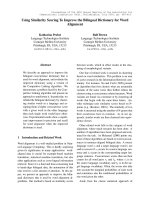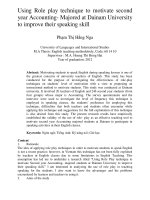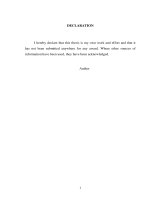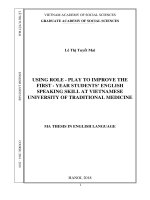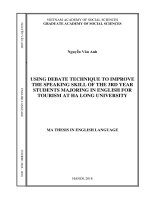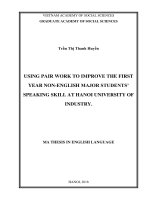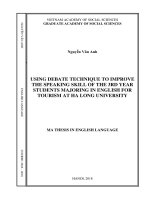Using Active Teaching to improve English Speaking Skill for first-year Non- English Majoring Students AOF”.PDF
Bạn đang xem bản rút gọn của tài liệu. Xem và tải ngay bản đầy đủ của tài liệu tại đây (1.98 MB, 67 trang )
DECLARATION
I hereby declare that this thesis is my own work and effort and that it
has not been submitted anywhere for any award. Where other sources of
information have been used, they have been acknowledged.
Author
i
ACKNOWLEDGEMENT
This thesis would not have been possible without the support of many
people.
First of all, I would like to thank our respected supervisor – Ms. Bui
Thi Tuyet Mai, a lecturer of English Department, Academy of Finance for her
immense support throughout my research. Without her continuous guidance
and support during my project, my project would not be completed.
I also want to give my kind regards to all teachers and students of the
Faculty of Foreign Language for their kindness and help in my practicing time
at this faculty.
ii
ABSTRACT
This thesis concentrates on Active Teaching and how Active Teaching
would help to improve the teaching and learning quality of English speaking
skill for first year Non-English Majoring students AOF. Throughout the
thesis, basic information on English speaking and Active Teaching will be
provided: the definition and the description. Also included in the thesis are
figures and facts on current situation of English speaking skill at classes of
first year non-gifted students. Interviewing method and questionnaire will be
used in the thesis to collect students’ opinions on the current and the planned
teaching methods. Teachers’ view would be taken into consideration to find
out what they think about the changes and obstacles may exist when new
methods are experimented. The thesis concludes with the recommendation on
the application of Active Teaching methods in order to improve speaking skill
for first year Non-English Majoring students.
iii
TABLE OF CONTENTS
DECLARATION……………………………………………………………...i
ACKNOWLEDGMENT………………………………………………...……ii
ABSTRACT…………………………………......................... ……………...iii
LIST OF ABBREVIATIONS………………………………………………..iv
LIST OF TABLES………………………………….........................................v
INTRODUCTION ............................................................................................... 1
1. Rationale........................................................................................................ 1
2. Aims of the study .......................................................................................... 2
3. Scope of the study ......................................................................................... 2
4. Methodology ................................................................................................. 3
5. Organization of the study .............................................................................. 3
CHAPTER 1: BASIC THEORY OF SPEAKING AND ACTIVE
TEACHING ......................................................................................................... 4
1.1. Speaking skill and its related concepts ...................................................... 4
1.1.1 Definition of Speaking ......................................................................... 4
1.1.2 The importance of speaking skill in classrooms .................................. 4
1.1.3 Skills and knowledge good English speaker need ............................... 5
1.1.4 Teaching Speaking ............................................................................... 6
1.1.4.1 What is Teaching Speaking? ......................................................... 7
1.1.4.2 How to Teach Speaking? .............................................................. 7
1.2 Active teaching in a speaking lesson .......................................................... 8
1.2.1 Definition and description of active teaching ...................................... 8
1.2.1.1 Definition of active teaching ......................................................... 8
1.2.1.2 Description of active teaching ...................................................... 9
1.2.2 Methods of Active Teaching ................................................................ 9
1.2.2.1 Brainstorming ................................................................................ 9
1.2.2.2 A visitor to the classroom ............................................................. 9
1.2.2.3 Personal interview ....................................................................... 10
1.2.2.4 Role-Play ..................................................................................... 10
1.2.2.5 Making a presentation ................................................................. 10
1.2.2.6 Case studies ................................................................................. 10
1.2.2.7 Group work/ Team work/ Discussion Groups ............................ 11
1.2.2.8 Class debate ................................................................................. 11
CHAPTER 2: THE STUDY ............................................................................. 13
2.1 Description of the subjects ........................................................................ 13
2.1.1 Description of first-year Non-English Majoring students ................. 13
2.1.2 Description of first-year Non-English Majoring students’ current
state of English speaking skill ..................................................................... 13
2.2 Researches on current state of speaking teaching and the application of
Active Teaching methods ................................................................................ 14
2.2.1 Research methods............................................................................... 14
2.2.2 Research’s results ............................................................................... 15
2.2.2.1 Number of speaking periods in total English study program ..... 15
2.2.2.2 Current active teaching methods used ........................................ 18
2.2.2.3 Teachers’ opinions on the use of Active teaching methods for
speaking skill. .......................................................................................... 19
2.2.2.4 Obstacles experienced by the teachers when applying Active ... 21
2.2.2.5 Students’ opinions on the use of current Active teaching
methods ................................................................................................... 23
2.2.2.4 Student’s obstacles on the application of more Active ............... 24
2.3 What to draw from the findings ................................................................ 25
2.3.1 From students’ perspective ................................................................ 25
2.3.2. From teachers’ perspective ............................................................... 26
2.4 Conclusion................................................................................................. 27
2.4.1. How active teaching methods used ................................................... 27
2.4.2. Obstacles in applying Active Teaching ................................................ 29
2.4.2.1. Students’ obstacles ......................................................................... 29
CHAPTER 3: RECOMMENDATIONS ......................................................... 31
3.1. Recommendation on change within faculties involved ........................... 31
3.1.1. Recommendation on change to Non-English majoring faculties ..... 31
3.1.2. Recommendation on change to Faculty of Foreign Language ......... 32
3.1.3. Recommendation on change to teachers ........................................... 33
Extra method 2: Case Studies ............................................................................. 35
3.1.4.
Recommendation on change to students ....................................... 40
CONCLUSION .................................................................................................. 42
REFERENCE .................................................................................................... 44
APPENDIX
LIST OF ABBREVIATIONS
AOF: Academy of Finance
FFL: Faculty of Foreign Language
EOSL: English for Speakers of Other Languages
AT: Active Teaching
iv
LIST OF TABLES
Table 1: Speaking activities and topics/drills in the course book “Business
Basics”
Table 2: Active Teaching methods, which being used
Table 3: Implementation of active teaching methods, teachers’ opinion (by
percentage)
Table 4: Obstacles experienced by the teachers when applying group work in
the speaking class by percent
Table 5: Application of current active teaching methods, students’ opinion (by
percent)
Table 6: Students’ obstacles when applying AT methods
v
INTRODUCTION
*****
1. Rationale
Vietnam is in the transitional period into the knowledge economy, in
which universities contributes greatly to the economic growth. One of the
challenges faced by universities is how to train students whose qualifications
are needed by the society. English speaking skill ranks among those
qualifications that are highly appreciated by the modern world. A puzzle
appears challenging the education system: How to train students that are able
to speak English fluently, to use English to communicate wherever and
whenever they want in order to benefit themselves and the society?
Academy of Finance has already realized the question raised by the
society on English speaking skill. It also keeps in mind its role of devoting
itself to the education system, as well as the economic growth. New plans
have been suggested on English speaking lessons with the hope of making
students approach English speaking skill right from the moment they start
their study at the university.
In learning speaking skill, the students often find some problems. The
problem frequently found is that their native language causes them difficult to
use the foreign language. Other reason is because of motivation lack to
practice the second language in daily conversation. They are also too shy and
afraid to take part in the conversation. Many factors can cause the problem of
the students’ speaking skill namely the students’ interest, the material, and the
media among others including the technique in teaching English. Many
techniques can be applied including Active Teaching methods because many
research findings say that they are effective to use in teaching speaking.
1
Non-English Majoring students AOF, like any other English learners,
have to face with these problems, and find it hard to reach the target of
outcome standard on English speaking needed by the society. To solve this
problem, AOF – in general, and the teachers of Faculty of Foreign Language
– in detail, are making effort to find out suitable methods to help Non-English
Majoring students come up with the general standards on English speaking
skill. This perception by AOF has inspired me to pursue my research on
“Using Active Teaching to improve English Speaking Skill for first-year NonEnglish Majoring Students AOF”. I wish that this thesis would provide
effective recommendation for AOF to improve English speaking skill
teaching and learning, thus helping the university to have satisfactory
outcomes – students that are qualified by the society in English speaking skill.
2. Aims of the study
As mentioned above, in order to understand how the Academy of
Finance is running its English speaking teaching - learning system for NonEnglish Majoring students, what is the current results and how Active
Teaching methods would help to improve these results, this thesis will
research English speaking skill, current situation of English speaking teaching
at AOF, Active Teaching together with its meanings, components and
efficiency; suggesting some recommendation to improve student’s English
speaking ability in the Academy.
3. Scope of the study
The research scope of the study is restrained in Non-English Majoring
Faculties, Academy of Finance. Moreover, the research focuses on analyzing
2
the current situation and improving the English speaking teaching and
learning with Active Teaching methods.
4. Methodology
The data methods are used to collect and analyze the information about
English speaking skill and the current teaching – learning situation at AOF.
The data used in this study are mainly primary data: data from the teachers
and students of AOF, from internet and books.
5. Organization of the study
Beside introduction and conclusion, my thesis consists of three main
chapters as follow:
The first part: Introduction briefly states the rationale of the study, aims
of the study and scope of the research.
Chapter 1: Literature review, discussing the definition of speaking
skill and Active Teaching, providing the description of each one.
Chapter 2: Current situation, finding and analyzing current situation of
speaking lessons for Non-English Majoring Students AOF.
Chapter 3: Recommendation, presenting the obstacles in applying
Active Teaching and suggesting recommendation on the application of Active
Teaching to improve speaking skills for first-year Non-English Majoring
Students AOF.
3
CHAPTER 1: BASIC THEORY OF SPEAKING AND ACTIVE
TEACHING
1.1. Speaking skill and its related concepts
1.1.1 Definition of Speaking
In Oxford Advanced Dictionary the definition of speaking is to express
or communicate opinions, feelings, ideas, etc, by or as talking and it involves
the activities in the part of the speaker as psychological, physiological
(articulator) and physical (acoustic) stages.
According to Chaney, speaking is the process of building and sharing
meaning through the use of verbal and non-verbal symbols, in a variety of
contexts. While another expert, Theodore Huebner said Language is
essentially speech, and speech is basically communication by sounds. And
according to him, speaking is a skill used by someone in daily life
communication whether at school or outside. The skill is acquired by much
repetition; it primarily a neuromuscular and not an intellectual process. It
consists of competence in sending and receiving messages.
From the above definition, it can be inferred that speaking is expressing
ideas, opinions, or feelings to others by using words or sounds of articulation
in order to inform, to persuade, and to entertain that can be learnt by using
some teaching - learning methodologies.
1.1.2 The importance of speaking skill in classrooms
Among the four skills in learning English, speaking and writing are the
productive skills. However, speaking is regarded as very important for
language teaching and learning. Speaking is a bridge to reach other skills.
Speaking helps learners to read better, to listen more effectively and write
4
more accurately. Speaking is surely the most effective means of
communication. (Ur, 1996)
There are two most important reasons why speaking should be taught in
classrooms. The first reason is speaking is a good source of motivation for
students. Nunan (1991) points out, “success is measured in terms of the ability
to carry out a conversation in the (target) language”. For the students who
have ability to speak English eligibly, they want to speak English; they know
to express themselves in English. Thus, they always speak when possible. But
for those who cannot speak English well, they do not want to speak in group.
As a result, they may soon get de-motivated and lose interest in learning
English. In addition to this, in the English speaking class, if the speaking
activities are organized in the suitable way, speaking can have a lot `of fun
and therefore can raise motivation in the learners. If the speaking is practiced
successfully, the other skills can also be improved through speaking.
For the second reason, nowadays, the demand for communication
among people is really important. Without it, the life does not exist. For this,
speaking always plays an important role in people’s lives. Speaking is
considered as survival skill in real life (Ur, 1996; p 134)
For the ideas above, speaking skill also plays the key role in foreign
language learning and teaching.
1.1.3 Skills and knowledge good English speaker need
A speaker's skills and speech habits have an impact on the success of
any exchange (Van Duzer, 1997). Speakers must be able to anticipate and
then produce the expected patterns of specific discourse situations. They must
also manage discrete elements such as turn-taking, rephrasing, providing
5
feedback, or redirecting (Burns & Joyce, 1997). Other skills and knowledge
that instruction might address include the following:
-
producing the sounds, stress patterns, rhythmic structures, and
intonations of the language;
-
using grammar structures accurately;
-
assessing characteristics of the target audience;
-
selecting vocabulary that is understandable and appropriate for the
audience, the topic being discussed, and the setting in which the speech act
occurs;
-
applying strategies to enhance comprehensibility;
-
using gestures or body language; and
-
paying attention to the success of the interaction and adjusting
components of speech.
1.1.4 Teaching Speaking
Speaking is a crucial part of second language learning and teaching.
Despite its importance, for many years, teaching speaking has been
undervalued and English language teachers have continued to teach speaking
just as a repetition of drills or memorization of dialogues. However, today's
world requires that the goal of teaching speaking should improve students'
communicative skills, because, only in that way, students can express
themselves and learn how to follow the social and cultural rules appropriate in
each communicative circumstance.
6
1.1.4.1 What is Teaching Speaking?
What is meant by teaching speaking is to teach English language
learners to:
1) Produce the English speech sounds and sounds patterns.
2) Use words and sentence stress, intonation patterns and the rhythm of the
second language.
3) Select appropriate words and sentences according to the proper social
setting, audience, situation and subject matter.
4) Organize their thoughts in a meaningful and logical sequence.
5) Use language as a means of expressing values and judgments.
6) Use the language quickly and confidently with few unnatural pauses, which
is called fluency.
1.1.4.2 How to Teach Speaking?
When teaching young learners we constantly have to keep in mind
the fact that what we have in front of us is a mixed class with varied abilities,
expectations, motivation level, knowledge and last but not least, different
learning styles. Thus, we need to vary our approaches and offer as much
opportunity as possible to make the whole class find a little something to hold
on to, expand and grow.
Young learners are like sponges, they soak up everything we say
and how we say it. Thus clear and correct pronunciation is of vital
importance, since young learners repeat exactly what they hear. What has
been learned at an early stage is difficult to change later on. One rule that
applied here is slowly and steadily through constant revision and recycling.
With the help of mixed activities, such as dialogues, choral revision, chants,
7
songs, poems and rhymes, students speaking abilities grow, their
pronunciation gets better and their awareness of the language improves. When
applying the above-mentioned tools into the teaching practice, what should be
kept in mind is that interaction is an important way of learning. Therefore,
increased oral emphasis should be included in our teaching to give the
students as much speaking time as possible.
Now many linguistics and English as second language (ESL)
teachers agree on that students learn to speak in the second language by
"interacting". Communicative language teaching and collaborative learning
serve best for this aim. Communicative language teaching is based on reallife situations that require communication. By using these methods in ESL
classes, students will have the opportunity of communicating with each other
in the target language. In brief, ESL teachers should create a classroom
environment where students have real-life communication, authentic
activities, and meaningful tasks that promote oral language. This can occur
when students collaborate in groups to achieve a goal or to complete a task.
1.2 Active teaching in a speaking lesson
1.2.1 Definition and description of active teaching
1.2.1.1 Definition of active teaching
Active teaching and learning involves the use of strategies which
maximize opportunities for interaction. Active teaching and learning offers
opportunities for interaction between teachers and students, amongst the
students themselves, as well as between students and the materials, the topic
itself or the academic discipline.
8
1.2.1.2 Description of active teaching
Active teaching involves the use of instructional techniques
designed for meaningful student engagement in the discovery of knowledge.
Philosophically, the approach has a long history, from Socrates to John
Dewey to the teaching case method refined at Harvard University. They
conscious selection of goals for the classroom and methods for teaching helps
create a sense of purpose in the educational process. It also represents
collaboration – a commitment on the part of instructors and students to
enliven the educational environment.
1.2.2 Methods of Active Teaching
1.2.2.1 Brainstorming
On a given topic, students can produce ideas in a limited time.
Depending on the context, either individual or group brainstorming is
effective and learners generate ideas quickly and freely. The good
characteristic of brainstorming is that the students are not criticized for their
ideas so students will be open to sharing new ideas.
1.2.2.2 A visitor to the classroom
A visitor can be invited to the classroom because of his/her expertise
in a given area or to interact with the young people. It is advisable to brief the
visitor about the class group e.g. what they are studying, how far they have
gone with their course and topic, the age group etc. The visitor will want to
know the format of the visit e.g. question and answer, presentation etc. A
question and answer session is generally better for involving the students.
The following are some of the points that students may want to discuss.
9
1.2.2.3 Personal interview
Students can conduct interviews on selected topics with various
people. It is a good idea that the teacher provides a rubric to students so that
they know what type of questions they can ask or what path to follow, but
students should prepare their own interview questions. After interviews, each
student can present his or her study tot the class. Moreover, students can
interview each other and “introduce” his or her partner to the class.
1.2.2.4 Role-Play
Role-plays require students to place themselves in a particular
situation or take a committed position on a key issue in the course. For
example, students might become players in an historical event, one requiring
they research positions and argue for certain actions or decisions. In scientific
fields, students can become actual representatives of a physical process,
acting it out to make it more concrete.
1.2.2.5 Making a presentation
Students are asked to speak in front of a group of people about a
required topic with or without time limits. Normally, students often use visual
aids like pictures or slide shows to make the presentation livelier.
1.2.2.6 Case studies
More structured than role plays, case studies are stories, often based
on real world examples, that place students in the role of decision maker.
They contain the data students need to make sense of the situation, but don’t
usually contain analysis or conclusions. Students must make sense of the
information and come to appropriate conclusions regarding the next actions to
take, or the kind of data thy will need in order to come to an appropriate
10
conclusion. Case studies thus test students’ analytic and problem solving
approaches while making them conscious of how to use the skills they’ve
been developing in the class.
1.2.2.7 Group work/ Team work/ Discussion Groups
After a content-based lesson, a discussion can be held for various
reasons. students are divided into group/team, and may aim to arrive at a
conclusion, share ideas about an event, or find solutions in their discussion
groups. Before the discussion, it is essential that the purpose of the discussion
activity is set by the teacher. In this way, the discussion points are relevant to
this purpose, so that students do not spend their time chatting with each other
about irrelevant things.
1.2.2.8 Class debate
Class debate can be used with either large or small groups. In either
case, it is often best to begin with a brief class discussion of the issues
involved in the debate topic. This provides a context for the debate, a sense of
the sub-issues involved, and a gauge of class feelings on the issues. At this
time the instructor should also make clear the rules of the debate, including
time allotted to each side and rules for speaking. (Formats and rules for
several kinds of debates can be found on line.) If a small group format is used,
divide the class into groups and give them time to choose their topic and
resolution. (Debates are often won or lost in the wording of the resolution, so
it is important that the students have some leeway in deciding upon this
wording.) After the sides and resolution are decided, the students will need
time to prepare their arguments and tactics. If the class is to perform the
debate as a large group, the instructor usually serves as moderator. In this
case, the two sides should also be given some time to develop their positions
11
and their strategies of argument before the debate begins. In either a small- or
large-group format, students may be instructed to argue for their own beliefs
or against them, depending on the instructor’s objectives. Likewise, the
instructor may choose to have students argue first an affirmative position and
then a negative one. Some instructors prefer to summarize the debate at the
end; this can clarify the information presented and direct students to focus on
the key points derived from the exercise. Other instructors refrain from
summarizing students’ contributions, thereby preserving the variety of
opinions and perspectives that were expressed over the course of the debate.
12
CHAPTER 2: THE STUDY
2.1 Description of the subjects
2.1.1 Description of first-year Non-English Majoring students
In Academy of Finance, those who study English are divided into two
groups: English Majoring and Non-English Majoring students. For English
Majoring students, the expected results from the university and the society
seem to be easier to achieve, as they have already had the solid base of
English, its knowledge and skills. On the contrary, Non-English Majoring
students find it hard to come up with the outcome English standards. Firstyear Non-English Majoring students are the ones who have just transited from
High School Education to University one. All they have in mind about
English is the knowledge that they learnt in their Secondary and High School.
Researches on English study program of Non-English Majoring students
show that although English is one of the subject chosen for the High School
Graduation Exam, the number of English periods takes only 10% of the total
study program (3 periods in total 30 periods per week). In these English
periods, time spent for speaking skill is only one-fourth of the lesson, or
sometimes no time for speaking skill. Therefore, it can be concluded that the
English knowledge base of Non-English Majoring students is very weak,
similarly is their English Speaking.
2.1.2 Description of first-year Non-English Majoring students’
current state of English speaking skill
From the above features, it can be pointed out that English is the
weakness of a majority of Non-English Majoring students. Weak base of
English knowledge, and not much time spent practicing speaking English
13
result in quite bad Speaking skill in a lot of students. Only a few students who
had set their goal of English study from the start and have their own methods
of learning English speaking can do well in this skill. However, these students
count for a small number of first-year Non-English Majoring students. Thus,
to conclude, English speaking skill of mostly every first-year Non-English
Majoring student is seriously bad and needs improving so much.
2.2 Researches on current state of speaking teaching and the
application of Active Teaching methods
2.2.1 Research methods
To collect information concerning the current situation of teaching and
learning speaking skill at Non-English Majoring Faculty, AOF, the author did
a lot of class observation, and conducted two survey questionnaires; one was
delivered to 100 students and the other to 6 teachers of English at AOF.
The first questionnaire was designed for the students to gain answers for two
following questions:
Question 1: What do you think about currently used active teaching methods
on speaking skill?
Question 2: What are your obstacles when attending classes that use AT?
The second questionnaire is designed for the teachers to know these two
things:
Question 1: What do you think about the application of active teaching
methods in speaking class?
Question 2: What are your obstacles when applying these methods?
14
100 copies of the questionnaire delivered to the students and 06 copies of the
questionnaire delivered to the teachers have been all responded. Author’s
class observation was successful due to the help and support of all teachers
and the students.
2.2.2 Research’s results
2.2.2.1 Number of speaking periods in total English study program
The course book is Business Basics published in 1995 by Oxford
University Press, and has been used as an official course book. It was written
by David Grant and Robert McLarty to fit students’ level of English and
educational goals of the universities. Business Basics was, according to what
is stated in the Introduction, the book from which “Students have the
opportunity to actively engage in communication activities that can be readily
transferred to their real-life work or to a pre-experience learner setting. The
activities in the Business Basics series, whether listening, speaking or writing,
are designed to simulate activities which are as close as possible to the reallife business situations in which students are going to find themselves”.
However, the course book appears to focus on grammar and grammar
exercises other than communication skills. This can be easily noticed on the
very first page of the book, which presents each unit with a topic and all
grammar items it is about, without any skills named. As considerations go
further to contents of each unit, this seems to be proved right. Activities for
speaking skill, for example, take small amount in each unit. To be more
detailed, all activities and topics or drills in terms of speaking skill in firstyear Non-English Majoring students are presented as the following. (Here we
consider only 10 first units, as that’s all what first-year Non-English study)
15
Table 1: Speaking activities and topics/drills in the course book
“Business Basics” (Source: Abstracted from the contents of 10 first lessons in
the book “Business Basics”)
Unit
Speaking activities
Topics/drills
- Checking spelling
Pair work
- Ask for information
1
Individual work
Talk
about
your
company/
your
country
- Choosing a hotel
2
Pair work/ Group work
- Hotel reservation
- Ask for information
- Going on a business trip
Pair work
- Ask for information
3
Individual work
Eating out
- Pronunciation
Individual work
- Introductions and conversation
openers
4
- Greeting conversations
Pair work/ Group work
- Working
companies
16
in
multinational
- Business trip abroad
Pair work
- Question-making
5
Individual work
Famous stores in your country
Individual work
Fixing the date
6
- Check the information
Pair work
- Telephone conversations
Pair work/ Group work
- Famous inventions
- Travelling
7
Individual
Pronunciation
- The rich and related topics
8
Pair work/ Group work
- A place to live in
Pair work
Dialogues practicing
Individual work
Pronunciation
9
- Present-giving art
Group work/ Pair work
- Making an interview
10
Individual work
Talk about your own job
It can be learned from the table that the variety of speaking activities is
very limited, with pair work as the most common. It therefore depends very
much on students’ ability and enthusiasm to study. And because first-year
17
